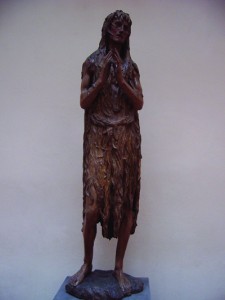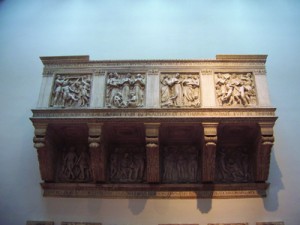Donatello is often referred to as the first Renaissance sculptor. He is the artistic grandfather of Michelangelo, who probably learnt more by studying Donatello?s work from the century earlier than any contemporary masters of his time…
 Donatello was the first sculptor since antiquity to make paramount, in his artistic production, the aim of communicating the psychological character of his subjects to the viewer, something he succeeded in doing with extraordinary talent.
Donatello was the first sculptor since antiquity to make paramount, in his artistic production, the aim of communicating the psychological character of his subjects to the viewer, something he succeeded in doing with extraordinary talent.
Donatello worked in all materials; stone, marble, wood, clay and bronze, with equal dexterity. However, his real genius was that his works transmit such a range of emotions that I find they no longer belong to a particular moment in history, but instead can be contemporary and eternal in their reception. Donatello seemed to step into his commissions and, while sculpting them, experience his subject?s state of mind, so as to be able to render them with the greatest sympathy.
Take his wooden Mary Magdalene (circa 1450) for example. Most often, Mary was shown as a good looking woman with long flowing hair, which harked back to the wayward and licentious life she led before becoming a follower of Christ. This representation doesn?t satisfy Donatello as it is void of any sense of Mary Magdalene the repentant sinner, her most significant role in the Christian story.
Donatello decided to show her as she would be after her encounters with Christ, when she had wholly renounced all worldly desires for complete spiritual fulfilment. He gives her a wasted body with only her hair covering her, but her gaunt drawn face holds her strong and steady eyes. Mary?s attention is now internal, her soul is nourished to the detriment of her mortal body.
 When Donatello received the commission from the cathedral committee for a singing gallery, or cantoria, they requested that he visually interpret psalm 150. There were two cantoria commissioned at the same time, the other to be carried out by Luca della Robbia. Both were to use children in their representation.
When Donatello received the commission from the cathedral committee for a singing gallery, or cantoria, they requested that he visually interpret psalm 150. There were two cantoria commissioned at the same time, the other to be carried out by Luca della Robbia. Both were to use children in their representation.
The great sculptor Luca della Robbia depicted beautiful children, in a series of four bas-reliefs, playing instruments in unison filled with praise for the Lord. Donatello, however, rather than merely depicting the psalm, succeeded in evoking the children?s demeanour who were filled with the Lord?s praise.
They careen at top speed, undeterred by any social or earthly restraint, as only children can do. Donatello shows us the untamed joy in these stone babies. He transmits the internal joy rather than just their external physical appearance.
Donatello?s appellation as the first Renaissance sculptor is well-earned, because his search to bring forth the soul of every subject he portrayed reflected the atmosphere of the early 15th century in Florence. Man,his role as an individual and how he uses his time on earth ? distinct from the church ? was taking over as main protagonist on the stage of life.
